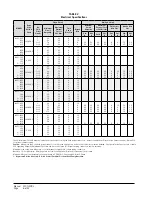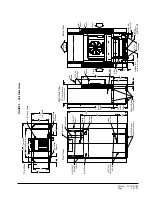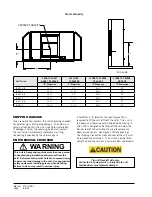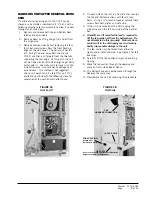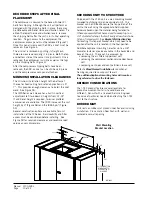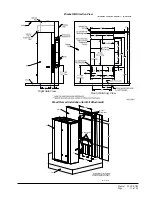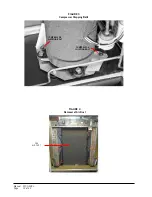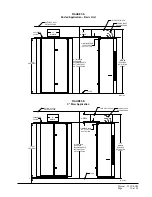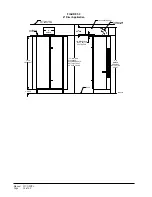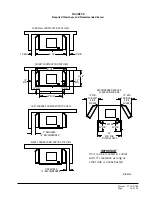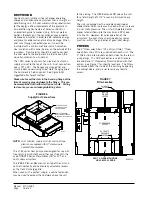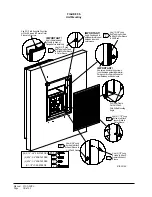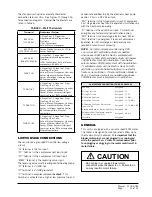
Manual 2100-578L
Page
20 of 42
INSTALLATION
MOUNTING THE UNIT
The wall sleeve is attached to the I-TEC unit from the
outside of the building. See Figures 9A & 9B. Refer to
wall sleeve Manual 2100-562 supplied with sleeve.
Following are the steps for attaching the I-TEC to the
wall sleeve.
1. Lift the unit into place making sure that it is
aligned side-to-side. Align unit with rubber mat.
2. Push the unit back until the rear panel touches the
sleeve gasket.
3. This unit must be level from side-to-side and from
front-to-back. If adjustments are necessary, shim
up under the base rails with sheets of metal or any
substance not affected by moisture.
4. Attach the sleeve to the unit using the ten (10) ¾"
long self-tapping screws supplied with the sleeve.
5. The exhaust sleeve has three (3) ¾" long screw
slots in each side flange. Line these up with the
screw engagement holes in the fan panel. Attach
using six (6) ¾" long pointed sheet metal screws
supplied with the sleeve. Extend the sleeve out
until it is flush with the louver grill attachment
angles.
6. Lock the sleeve in place using two (2) ½" long
pointed sheet metal screws on each side by shooting
through the slot into a pre-punched hole.
7. A bottom trim piece is shipped loose for
installation beneath the doors. Attach the trim
piece to the unit with screws provided.
8. The compressor is secured to the base with two (2)
bolts for shipping. Both bolts are identified with a
tag. Remove shipping bolts (Figure 3).
WIRING – MAIN POWER
Refer to the unit rating plate and/or Table 2 for wire
sizing information and maximum fuse or circuit breaker
size. Each unit is marked with a “Minimum Circuit
Ampacity”. This means that the field wiring used must
be sized to carry that amount of current. Depending on
the installed KW of electric heat, there may be two field
power circuits required. If this is the case, the unit serial
plate will so indicate. All models are suitable only for
connection with copper wire. Each unit and/or wiring
diagram will be marked “Use Copper Conductors Only
suitable for at least 75°C”.
THESE INSTRUCTIONS
MUST BE ADHERED TO.
Refer to the National Electrical
Code (NEC) for complete current carrying capacity data
on the various insulation grades of wiring material. All
wiring must conform to NEC and all local codes.
The electrical data lists fuse and wire sizes (75°C
copper) for all models, including the most commonly
used heater sizes. Also shown are the number of field
power circuits required for the various models with
heaters.
The unit rating plate lists a “Maximum Time Delay Relay
Fuse” or circuit breaker that is to be used with the
equipment. The correct size must be used for proper
circuit protection, and also to assure that there will be
no nuisance tripping due to the momentary high starting
current of the compressor motor.
See
“START UP”
section for information on three phase
scroll compressor start-ups.
The field wiring conduit connections are located on the top
right-hand corner of the unit with a wire raceway to feed
the wires down to the circuit breaker(s). See Figure 10.
TABLE 3 – Operating Voltage Range
NOTE:
The voltage should be measured at the field
power connection point in the unit and while the unit
is operating at full load (maximum amperage operating
condition).
WIRING – LOW VOLTAGE WIRING
230/208V, 1 PHASE AND 3 PHASE EQUIPMENT
DUAL PRIMARY VOLTAGE TRANSFORMERS
All equipment leaves the factory wired on 240V tap.
For 208V operation, reconnect from 240V to 208V tap.
The acceptable operating voltage range for the 240 and
208V taps are as noted in Table 3.
TAP
RANGE
240V
253 – 216
208V
220 – 187
FIGURE 10
Component Location
VENT
OPTION
CONDENSER
COIL
WIRE
RACEWAY
COMPRESSOR
EVAPORATOR
COIL
CONTROL
PANEL
ELECTRIC
HEAT
INDOOR
BLOWER
OUTDOOR
FAN
LOW
VOLTAGE
REFRIGERANT
PORT

